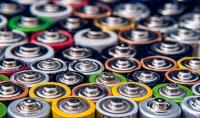Energy transformation according to WUT physicists

Researchers at the Faculty of Physics work on two of the three components of batteries: cathodes and electrolytes, photo: unsplash
Work on materials important for energy storage and conversion has become particularly important in recent times. This has been influenced by the changes and challenges facing the modern world. How do the activities of researchers at the Faculty of Physics of Warsaw University of Technology fit into this strategic research trend?
Researchers affiliated with the Department of Solid State Ionics have long been studying materials that could find applications in lithium-ion (Li-ion), sodium-ion (Na-ion) batteries, fuel cells or oxygen partial pressure sensors. The basic components of any electrochemical cell (which include Li-ion or fuel cells) are the cathode, electrolyte and anode. A team from the Faculty of Physics is conducting research on two of them - cathodes and electrolytes. The teams works on obtaining them and on characterization of their basic electrical, structural and thermal properties.
Our specialists focus on two main streams: conductors of lithium and sodium ions and oxygen ions.
An alternative to "spillable" batteries
Solid electrolytes with high lithium ion conductivity are being studied, among others, for future use in Li-ion cells. Among them there are compounds with the chemical formula Li7La3Zr2O12 (LLZO) having one of the highest lithium ion conductivities - it is almost as high as for liquid electrolytes currently used in batteries. Solid electrolytes, however, are safer, as the risk of a battery "spilling out" disappears. An important advantage of LLZOs is that they can be doped and made into mixed conductors, conducting both lithium ions and electrons. Such modified materials can serve as cathodes, showing high chemical compatibility and stability in contact with the original LLZO. This will make it possible to create all-solid lithium-ion cells, i.e. without liquid elements.
In parallel, research is being conducted on obtaining these materials in thin film form. The physics of thin films is completely different from the physics of volumetric materials - which makes it possible not only to study new phenomena, but also to build thin-film Li-ion cells. At the Centre for Advanced Materials and Technology (CEZAMAT), the Faculty of Physics is opening a new laboratory that will allow the manufacture of materials using the Pulsed Laser Deposition (PLD) method, which allows the deposition of small groups of atoms using a laser beam.
Multidirectional testing
Researchers at the Faculty of Physics are also investigating other groups of materials that conduct lithium ions, sodium ions and electrons - and thus potential cathode materials. Our researchers are developing various methods for obtaining them. One of them is sol-gel, which makes it possible to produce materials with small crystalline grains and a large specific surface area. This facilitates the incorporation of lithium ions into the structure of the material and improves electrical conductivity. In this way, cathode materials containing lithium, iron, manganese, cobalt, silicon and boron are obtained.
Another method is controlled annealing of glasses. Glass is an amorphous material with a disordered atomic structure. As a result of appropriate annealing, a local ordering of this structure occurs - crystalline grains of nanometre size are formed. The presence of such small grains has a positive effect on the electrical conductivity of the materials. The materials studied include glasses containing vanadium, phosphorus, lithium and iron. Finally, solid-phase synthesis methods are used, involving sintering of suitable powders at high temperatures. With their help, dense ceramic materials can be obtained.
Another group of solid electrolytes under study are composites of phosphorus, titanium and lithium compounds (LTP and LATP) with ionic liquids (liquids consisting solely of ions). Such composites combine the positive characteristics of solid electrolytes (stability) and ionic liquids (high conductivity of lithium ions). This makes them the most promising electrolyte materials for future Li-ion batteries. Lithium electrolytes obtained in the form of polymers are also being studied. They have the advantage of high flexibility, which could be crucial for flexible batteries, placed in clothing, for example.
Challenges of high temperatures
Among oxygen ion conductors, those based on bismuth oxide, Bi2O3 deserve special attention. One of the varieties of this compound, d-phase, is the best known solid conductor of oxygen ions, and for this reason - a very serious candidate for the electrolyte in high-temperature fuel cells.
Fuel cells are used in electric cars, among other applications. The reaction of hydrogen with oxygen in such cell produces electricity, and the only exhaust is pure water. Unfortunately, in order to obtain the d- Bi2O3 phase, it is necessary to heat bismuth oxide to temperatures in the 730-825 °C range. Research work on Bi2O3-based materials is concerned with the mechanisms of ionic conductivity and their relationship to the crystal structure (the way the atoms are arranged) of the material. In addition, ways are being sought to extend the stability range of the d-phase and its derivatives toward lower temperatures. This can be done, among others, by forming compounds of bismuth oxide with vanadium and another metal (e.g., copper, magnesium) or by controlled crystallization of bismuth glasses, leading to precipitation of nanosized crystalline d-type phase, stable even at room temperature.
Recently, experimental studies have been complemented by computer simulations of materials and ion and electron transport phenomena using advanced molecular dynamics (MD) and ab initio methods.
In addition to the study of new electrolytic and electrode materials, the Department of Solid State Ionics conducts measurements of finished Li-ion cells and works on modelling the wear and degradation phenomena of such cells.
source: www.fizyka.pw.edu.pl







